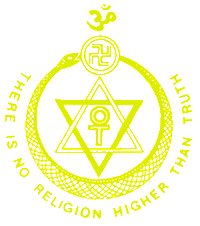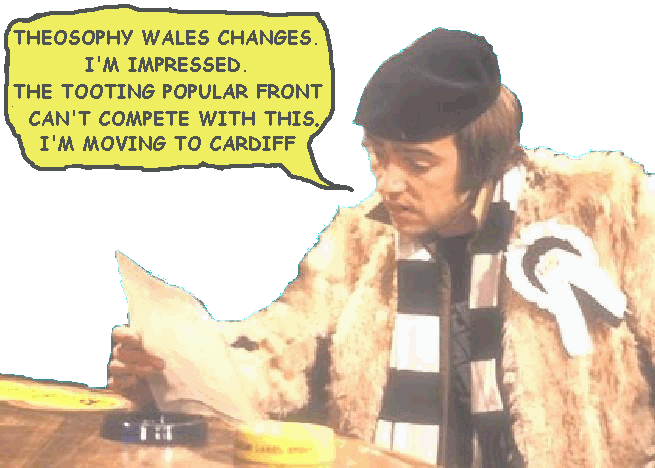HORNET

The
Wolseley Hornet 1960s model
An
upmarket version of the Mini

A
1930s Wolseley Hornet sports car
The
bodywork for these was made to order by a coachbuilder
of the customer’s choice and there were many
variations of this car.
The
series ran from 1930 to 1935
The Wolseley Hornet both in its 1930s sports
car
incarnation, and its 1960s posh mini version, has
very
little (in fact nothing) to do with Theosophy
but
we have found that Theosophists and new
enquirers
do like pictures of classic cars
and
we get a lot of positive feedback.
You can find Theosophy Wales groups
in
Bangor, Cardiff, Conwy
& Swansea
Theosophy Wales has no controlling
body
and is made up of
independent groups
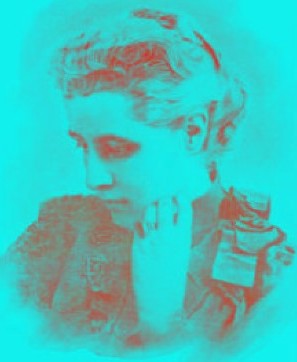
________________________
The
Ancient Wisdom
by
Annie
Besant
The Unity Underlying
all
Religions
Right thought
is necessary to right conduct, right understanding to right living, and the
Divine Wisdom – whether called by its ancient Sanskrit name of Brahma Vidya, or its modern Greek name of Theosophia,
Theosophy – comes to the
world as at once an adequate philosophy and an all-embracing religion and
ethic.
It was once
said of the Christian Scriptures by a devotee that they contained shallows in
which a child could wade and depths in which a giant must swim. A similar
statement might be made of Theosophy,
for some of its teachings are so simple and so practical that any person of
average intelligence can understand
and follow them, while others are so lofty, so
profound, that the ablest strains his intellect to contain them and sinks
exhausted in the effort.
In the
present volume an attempt will be made to place Theosophy before the
reader simply and clearly, in a way which shall convey its general principles
and truths as forming a coherent conception of the universe, and shall give
such
detail as is necessary for the understanding of their
relations to each other.
An elementary
textbook cannot pretend to give the fullness of knowledge that may be obtained
from abstruser works, but it should leave the student
with clear fundamental ideas on his subject, with much indeed to add by future
study but
with little to unlearn. Into the outline given by
such a book the student should be able to paint the details of further
research.
It is
admitted on all hands that a survey of the great religions of the world shows
that they hold in common many religious, ethical, and philosophical ideas. But
while the fact is universally granted, the explanation of the fact is a matter
of dispute.
Some allege
that religions have grown up on the soil of human ignorance tilled by the imagination,
and have been gradually elaborated from crude forms of animism and fetishism;
their likenesses are referred to universal natural phenomena imperfectly
observed and fancifully explained, solar and star worship being the universal
key for one school, phallic worship the equally universal key for another ;
fear, desire, ignorance, and wonder led the savage to personify the powers of
nature, and priests played upon his terrors and his hopes, his misty fancies,
and his bewildered questionings ; myths became scriptures and symbols facts,
and their basis was universal the likeness of the
products was inevitable.
Thus speak
the doctors of"Comparative Mythology," and
plain people are silenced but not convinced under the rain of proofs ; they cannot deny the likenesses, but they dimly
feel: Are all man’s dearest hopes and lofty imaginings nothing more than the
outcome of savage fancies and of groping ignorance? Have the great leaders of
the race, the martyrs and heroes of
humanity, lived, wrought, suffered and died deluded, for
the mere personifications of astronomical facts and for the draped obscenities
of barbarians?
The second
explanation of the common property in the religions of the world asserts the
existence of an original teaching in the custody of a Brotherhood of greatspiritual Teachers, who – Themselves the outcome of
past cycles of evolution – acted as the instructors and guides of the
child-humanity of our
planet, imparting to its races and nations in turn the
fundamental truths of religion in the form most adapted to the idiosyncrasies
of the recipients.
According to
this view, the Founders of the great religions are members of the one
Brotherhood, and were aided in Their mission by many other members, lower in
degree than Themselves, Initiates and disciples of various grades, eminent in
spiritual insight, in philosophical knowledge, or in purity of ethical wisdom.
These guided
the infant nations, gave them their polity, enacted their laws, ruled them as
kings, taught them as philosophers, guided them as priests ; all the nations of
antiquity looked back to such mighty men, demigods, and heroes, and they left
their traces in literature, in architecture, in legislation.
That such men
lived it seems difficult to deny in the face of universal tradition, of still
existing Scriptures, and of prehistoric remains for the most part now in ruins,
to say nothing of other testimony which the ignorant would reject.
The sacred
books of the East are the best evidence for the greatness of their authors, for
who in later days or in modern times can even approach the spiritual sublimity
of their religious thought, the intellectual splendour
of their philosophy, the breadth and purity of their ethic? And when we find
that
these books contain teachings about God, man, and the
universe identical in substance under much variety of outer appearance, it does
not seem unreasonable to refer to them to a central primary body of doctrine.
To that body we give the name Divine Wisdom, in its Greek form: THEOSOPHY.
As the origin
and basis of all religions, it cannot be the antagonist of any: it is indeed
their purifier, revealing the valuable inner meaning of much that has become mischievous
in its external presentation by the perverseness of ignorance and the
accretions of superstition ; but it recognises and
defends itself in each, and seeks in each to unveil its hidden wisdom. No man
in becoming a Theosophist need cease to be a Christian, a Buddhist, a Hindu ; he will but
acquire a deeper insight into his own faith, a firmer
hold on its spiritual truths, a broader understanding of its sacred teachings.
As Theosophy of old gave
birth to religions, so in modern times does it justify and defend them. It is
the rock whence all of them were hewn, the hole of the pit whence all were dug.
It justifies at the bar of intellectual criticism the deepest longings and
emotions of the human heart: it verifies our hopes for
man ; it gives us back ennobled our faith in God.
The truth of
this statement becomes more and more apparent as we study the various
world-Scriptures, and but a few selections from the wealth of material
available will be sufficient to establish the fact, and to guide the student in
his search for further verification. The main spiritual verities of religion
may
be summarised thus:
One eternal,
infinite, incognisable real Existence.
From THAT the
manifested God, unfolding from unity to duality to trinity.
From the
manifested Trinity many spiritual Intelligences, guiding cosmic order.
Man a
reflection of the manifested God and therefore a trinity fundamentally, his
inner and real Self being eternal, one with the Self of the universe.
His evolution
by repeated incarnations, into which he is drawn by desire, and from which he
is set free by knowledge and sacrifice, becoming divine in potency as he had
ever been divine in latency.
China which
is now a fossilised civilisation,
was peopled in old days by the Turanians, the fourth
subdivision of the great Fourth Race, the race which inhabited the lost
continent of Atlantis, and spread its offshoots over the world. The Mongolians,
the last subdivision of that same race, later reinforced its population, so
that in China we have traditions from ancient days, preceding the settlement of
the Fifth, or Aryan race in India. In the Ching Chang
Ching, or Classic of Purity, we have a fragment of an
ancient scripture of singular
beauty, breathing out the spirit of restfulness and
peace so characteristic of the "original teaching." Mr. Legge says in the introductory note to his translation [ The Sacred Books of the East] that the treatise –
"Is
attributed to Ko Yüan (or Hsüan), a Taoist of the Wü dynasty (A.D. 222-227), who is fabled to have attained
to the state of an Immortal, and is generally so denominated. He is represented
as a worker of miracles ; as addicted to
intemperance, and very eccentric in his ways. When
shipwrecked on one occasion, he emerged from beneath the water with his clothes
unwet, and walked freely on the surface. Finally he
ascended to the sky in bright day. All these accounts may safely be put down as
the figments of later time."
Such stories
are repeatedly told of Initiates of various degrees, and are by no means
necessarily "figments," but we are more interested in Ko Yüan’s
own account of the book.
"When I
obtained the true Tao, I recited this Ching [book]
ten thousand times. It is what the Spirits of heaven practise
and had not been communicated to scholars of this lower world. I got if from
the Divine Ruler of the
the Royal-mother of the West.
Now the
"Divine Ruler of the
deals with Tao – literally "the Way’ – the name
by which the One Reality is indicated in the ancient Turanian
and Mongolian religion. We read: "The Great Tao has no bodily form, but It produced and nourishes heaven and earth. The Great Tao
has no passions, but It causes the sun and the moon to
revolve as they do. The Great Tao has no name, but It effects the growth and
maintenance of all things. (i,1)
This is the
manifested God as unity, but duality supervenes:
Now the Tao
(shows itself in two forms), the Pure and the Turbid, and has (two conditions
of) Motion and Rest, Heaven is pure and earth is turbid ;
heaven moves and the earth is at rest . The masculine is pure and the feminine
is turbid ; the masculine moves and the feminine is
still. The radical (Purity) descended, and the (turbid) issue flowed abroad,
and thus all things were
produced (I, 2).
This passage
is particularly interesting from the allusion to the active and receptive sides
of Nature, the distinction between Spirit, the generator, and Matter, the nourisher, so familiar in later writings. In the Tao Te Ching the teaching as to the Unmanifested
and the Manifested comes out very plainly.
"The Tao
that can be trodden is not the enduring and unchanging Tao. The name that can
be named is not the enduring and unchanging name. Having no name, it is the
Originator of heaven and earth, having a name, it is the Mother of all
things…Under these two aspects it is really the same ;
but as development takes place it receives the different names. Together we
call them the Mystery (i, 1,2,4).
" Students of the Kabalah
will be reminded of one of the Divine Names, "the Concealed Mystery."
Again:
"There was
something undefined and complete, coming into existence before heaven and
earth. How still it was and formless, standing alone and
undergoing no change, reaching everywhere and in no danger (of being
exhausted). It may be regarded as the Mother of all things. I do not
know its name, and I give it the
designation of the Tao. Making an effort to give it a name,
I call it the Great. Great, it passes on ( in constant
flow). Passing on, it becomes remote. Having become remote, it returns (xxv,
1-3). "
Very
interesting it is to see here the idea of the forthgoing and the returning of
the One Life, so familiar to us in the Hindu Literature. Familiar seems the
verse: "All things under heaven sprang from It as existent (and named) ; that existence
sprang from It as non-existent (and not named)
(xl,2)".
That a
Universe might become, the Unmanifest must give forth
the One from whom duality and trinity proceed:
"The Tao
produced One ; One produced Two ; Two produced Three ;
Three produced all things. All things leave behind them the Obscurity (out of
which they have come), and go forward to embrace the Brightness (into which
they have emerged), while they are harmonised by the
Breath of vacancy (xlii, 1)."
"Breath
of Space" would be a happier translation. Since all is produced from It,
It exists in all:
"All
pervading is the Great Tao. It may be found on the left hand and on the right
…It clothes all things as with a garment, and makes no assumption of being
their lord ; - It may be named in the smallest things.
All things return (to their root and disappear), and do not know that it is It
which presides over
their doing so – It may be named in the greatest
things (xxxiv, 1, 2 )." Chwang-ze (fourth
century BC) in his presentation of the ancient teachings,
refers to the spiritual Intelligences coming from the Tao:
"It has Its root and ground (of existence) in Itself. Before there
were heaven and earth, from of old, there It was
securely existing. From It came the mysterious
existence of spirits, from It the mysterious existence of God (Bk. vi, Pt. I, Sec. vi, 7)."
A number of
the names of these Intelligences follow, but such beings are so well known to
play a great part in the Chinese religion that we need not multiply quotations
about them.
Man is regarded
as a trinity, Taoism, says Mr. Legge, recognising in him the spirit, the mind, and the body. This
division comes out clearly in the /Classic of Purity, in the teaching that man
must get rid of desire to reach union with
the One:
Now the
spirit of man loves purity, but his mind disturbs it. The mind of man loves
stillness, but his desires draw it away. If he could always send his desires
away, his mind of itself would be still. Let his mind
be made clean, and his spirit of itself becomes pure ….The reason why men are
not able to attain to
this is because their minds have not been cleansed,
and their desires have not been sent away. If one is able to send the desires
away, when he then looks at his mind it is no longer his: when he looks out at
his body it is no longer his ; and when he looks farther off at external
things, they are things which he has
nothing to do with ..(i, 3, 4).
Then, after
giving the stages of indrawing to "the condition of perfect
stillness," it is asked:
"In that
condition of rest independently of place, how can any desire arise? And when no
desire any longer arises there is the true stillness and rest. That true
(stillness) becomes (a) constant quality, and responds to external things
(without error) ; yea, that true and constant quality
holds possession of the
nature. In such constant response and constant
stillness there is constant purity and rest. He who has this absolute purity
enters gradually into the (inspiration of the ) True
Tao (i, 5)."
The supplied
words "inspiration of" rather cloud than elucidate the meaning, for
entering into the Tao is congruous with the whole idea and with other
Scriptures.
On putting
away of desire is laid much stress in Taoism ; a
commentator on the Classic of Purity remarks that understanding the Tao depends
on absolute purity, and
The acquiring
the Absolute Purity depends entirely on the putting away of Desire, which is
the urgent practical lesson of the Treatise. The Tao Teh
Ching says:
Always
without desire we must be found,
If its deep
mystery we would sound;
But if desire
always within us be,
Its outer
fringe is all that we shall see.( i,
3)
Reincarnation
does not seem to be so distinctly taught as might have been expected, although
passages are found which imply that the main idea was taken for granted and
that the entity was considered as ranging through animal as well as human
births. Thus we have from Chwang-ze the quaint and
wise story of a
dying man, to whom his friend said:
"Great
indeed is the Creator! What will He now make you to become? Where will He take
you to? Will he make you the liver of a rat or the arm of an insect? Szelai replied, "Wherever a parent tells a son to go,
east, west, south or north, he simply follows the command …Here now is a great
founder, casting his metal. If the metal were to leap up (in the pot) and say,
‘I must be made into a (sword like the ) Moysh,’ the great founder would be sure to regard it as
uncanny. So again, when a form is being fashioned in the mould of the womb, if
it were to say, ‘I must become a man, I must become a man,’ the Creator would
be sure to regard it as uncanny. When we once understand that heaven and earth
are a great melting pot and the Creator a great founder, where can we to go to
that shall not be right for us? We are born as from a quiet sleep and we die to
a calm awaking" (Bk. vi, Pt. I, Sec. vi).
Turning to
the Fifth, the Aryan Race, we have the same teachings embodied in the oldest
and greatest Aryan religion – the Brahmanical. The
eternal Existence is proclaimed in the Chhandogyopanishad
as "One only, without a second," and it is written:
It willed, I
shall multiply for the sake of the universe (vi, ii,
1, 3).
The Supreme
Logos, Brahman, is threefold – Being, Consciousness, Bliss, and it is said:
From This
arise life, mind and all the senses, ether, air, fire ,
water, earth the support of all ( Mundakopanishad,
ii,3).
No grander
descriptions of Deity can be found anywhere than in the Hindu Scriptures, but
they are becoming so familiar that brief quotation will suffice. Let the
following serve as specimens of their wealth of gems:
"Manifest,
near, moving in the secret place, the great abode, herein rests all that moves,
breathes, and shuts the eyes. Know That as to be
worshipped, being and non-being, the best, beyond the knowledge of all
creatures. Luminous, subtler than the subtle, in which the worlds and their
denizens are infixed.
That, this
imperishable Brahman ; That, also life and voice and mind…In the golden highest
sheath is spotless, partless Brahman ; That the pure
Light of lights, known by the knowers of the
Self…That deathless Brahman is before, Brahman behind, Brahman to the right and
to the left, below, above, pervading ;
this Brahman truly is the all. This is the best ( Mundakopanishad , II,ii, 1,2,9,11).
Beyond the
universe, Brahman, the supreme, the great, hidden in all beings according to
their bodies, the one Breath of the whole universe, the Lord, whom knowing
(men) become immortal. I know that mighty Spirit, the
shining sun beyond darkness… I know Him the unfading, the ancient, the Soul of
all, omnipresent by His nature, whom the Brahman-knowers
call unborn, whom they call eternal (Shvetashvataropanishad,
iii. 7,8,21).
When there is
no darkness, no day nor night, no being nor non-being (there is) Shiva even alone ; That the indestructible, That is to be worshipped by
Savriti, from That came forth the ancient wisdom. Not
above nor below, nor in the midst, can He be comprehended. Nor is there any
similitude for Him whose name is infinite glory. Not with the sight is
established His form, none may by the eye behold Him ;
they who know Him by the heart and by the mind, dwelling in the heart, become
immortal (Ibid., iv, 18-20).
That man in
his inner Self is one with the Self of the universe – "I am That" –
is an idea that so thoroughly pervades all Hindu thought that man is often
referred to as the "divine town of Brahman," [ Mundakopanishad
] the "town of nine gates," [ Shvetâshvataropanishad,
iii,14. ] God dwelling in the cavity of
the heart.[ Ibid., Ii]
"In one
manner is to be seen (the Being) which cannot be proved, which is eternal,
without spot, higher than the ether, unborn, the great eternal Soul…This great
unborn Soul is the same which abides as the intelligent (soul) in all living
creatures, the same which abides as ether in the heart ;
[ The "ether in the heart" is a mystical phrase used to indicate the
One, who is said
to dwell therein.] - in him it sleeps; it is the Subduer of all, the Ruler of all, the sovereign Lord of all
; it does not become greater by good works nor less by evil work. It is the
Ruler of all, the sovereign Lord of all beings, the Preserver of all beings,
the Bridge, the Upholder of the worlds, so that they fall not to ruin ( Brihadaranyakopanishad, IV, iv, 20,22, Trs.
Dr. E. Röer.)
When God is
regarded as the evolver of the universe, the threefold character comes out very
clearly as Shiva, Vishnu, and Brahma or again as Vishnu sleeping under the
waters, the Lotus springing from Him, and in the Lotus Brahma. Man is likewise
threefold, and in the Mândűkyopanishad the self is
described as conditioned by the physical body, the subtle body, and the mental
body, and then rising out of all into the One "without duality." From
the Trimurti (Trinity) come many Gods, connected with
the administration of the universe, as to whom it is said in the Brihadaranyakopanishad.
"Adore
Him, ye Gods, after whom the year by rolling days is completed, the Light of
lights, as the Immortal Life (IV, iv, 16)."
It is hardly
necessary to mention the presence in Brâhmanism of
the teaching of reincarnation, since its whole philosophy of life turns on this
pilgrimage of the Soul through many births and deaths, and not a book could be
taken up in which this truth is not taken for granted. By desires man is bound
to this wheel
of change, and therefore by knowledge, devotion,
and the destruction of desires, man must set himself free. When the Soul knows
God it is liberated. ( Shvetash,
I, 8.) The intellect purified by knowledge beholds Him. ( Mund., III, I,8 .) Knowledge joined to devotion
finds the abode of Brahman. ( Mund.,
III, ii,4).
Whoever knows
Brahman, becomes Brahman. ( Mund., III, ii,9 ) When desires cease the mortal
becomes immortal and obtains Brahman. ( Kathop.,
vi, 14). Buddhism, as it exists in its northern form, is quite at one with the
most ancient faiths, but in the southern form it seems to have let slip the
idea of the Logoic Trinity as of the One Existence
from which They came forth. The LOGOS in His triple manifestation is: the First
LOGOS, Amitâbha, the Boundless Light
; the Second, Avalokiteshvara, or Padmapani (Chenresi) ; the Third,
Manjusri – "the representative of creative
wisdom, corresponding to Brahmâ." ( Eitel’s
Sanskrit Chinese Dictionary, sub voce. ) Chinese Buddhism apparently does not
contain the idea of a primordial Existence, beyond the LOGOS, but Nepalese
Buddhism postulates Âdi-Buddha, from Whom Amitâbha arises. Padmapâni is said by Eitel to be
the representative of compassionate Providence and to correspond partly with
Shiva, but as the aspect of the Buddhist Trinity that sends forth incarnations
He appears rather to represent the same idea as Vishnu, to whom He is allied by
bearing the Lotus (fire and water, or Spirit and Matter as the primary
constituents of the universe).
Reincarnation
and Karma are so much the fundamentals of Buddhism that it is hardly worth
while to insist on them save to note the way of liberation, and to remark that
as the Lord Buddha was a Hindu preaching to Hindus, Brâhmanical
doctrines are taken for granted constantly in His
teaching, as matters of course. He was a purifier and a reformer, not an
iconoclast, and struck at the accretions due to ignorance, not at fundamental
truths belonging to the Ancient Wisdom.
"Those
beings who walk in the way of the law that has been well taught, reach the
other shore of the great sea of birth and death, that
is difficult to cross." (Udanavarga,
xxix. 37).
Desire binds
man, and must be gotten rid of:
"It is
hard for one who is held by the fetters of desire to free himself of them, says
the Blessed One. The steadfast, who care not for the happiness of desires, cast
them off and do soon depart (to Nirvana)….Mankind
has no lasting desires: they are impermanent in them who experience them ; free
yourselves then from what cannot last, and abide not in the sojourn of death (
Ibid., Ii, 6, 8).
He who has destroyed
desires for (worldly )goods, sinfulness, the bonds of the eye of the flesh, who
has torn up desire by the very root, he, I declare, is a Brahmana
(Ibid., xxxiii, 68)."
And a Brâhmana is a man "having his last body," (Udânavarga, xxxiii, 41) and is defined as one.
"Who,
knowing his former abodes (existences) perceives heaven and hell, the Muni, who has found the way to put an end to birth". (ibid., xxxiii,55). In the
exoteric Hebrew Scriptures, the idea of a Trinity does not come out strongly, though
duality is apparent, and the God spoken of is obviously the LOGOS, not the One Unmanifest: "I am the Lord and there is none else. I
form the light and create darkness; I make peace and create evil
; I am the Lord that doeth all these things." (Is., xlvii, 7)
Philo, however, has the doctrine of the LOGOS very clearly, and it is found in
the Fourth Gospel:
"In the
beginning was the Word [Logos] and the Word was with God and the Word was
God….All things were made by Him, and without Him was not anything made that
was made. (
In the Kabalah the doctrine of the One, the Three, the Seven, and
then the many, is plainly taught:
The Ancient
of the Ancients, the Unknown of the Unknown, has a form, yet also has not any
form. It has a form through which the universe is maintained. It also has not
any form, as It cannot be comprehended. When It first
took this form [Kether, the Crown, the First Logos]
It permitted to proceed from It nine brilliant Lights [Wisdom and the Voice,
forming with Kether the Triad, and then the seven
lower Sephiroth] …It is the Ancient of the Ancients,
the Mystery of the Mysteries, the Unknown of the Unknown.
It has a form
which appertains to It, since It appears (through it) to us, as the Ancient Man
above all as the Ancient of the Ancients, and as that which there is the Most
Unknown among the Unknown. But under that form by which It
makes Itself known, It however still remains the Unknown (Issac
Myer’s Qabbalah, from the Zohar,
pp. 274-275).
Myer points
out that the "form" is "not ‘the Ancient of the Ancients,’ who
is the Ain Soph. Again:
"Three
Lights are in the Holy Upper which Unite as One ; and they are the basis of the
Thorah, and this opens the door to all….Come, see! the mystery of the word. These are three degrees and each
exists by itself, and yet all are One and are knotted in One, nor are they
separated one from another….Three come out from One, One exists in Three, it is
the force between Two, Two nourishes One. One nourishes many sides, thus All is One. (ibid., 373, 375,376).
Needless to
say that the Hebrews held the doctrine of many Gods – "Who is like unto
Thee, O Lord, among the Gods?" –and of multitudes of
subordinate ministrants, the "Sons of God," the "Angels of the
Lord," the "Ten Angelic Hosts."(Exodus, xv,ii.)
Of the
commencement of the universe the Zohar teaches:
In the
beginning was the Will of the King, prior to any existence which came into
being through emanation from this Will. It sketched and engraved the forms of
all things that were to be manifested from concealment into view, in the
supreme and dazzling light of the Quadrant [the Sacred Tetractys]
(Myer’s
Quabbalah, pp. 194-95).
Nothing can
exist in which the Deity is not immanent, and with regard to Reincarnation it
is taught that the Soul is present in the divine Idea ere coming to earth ; if
the Soul remained quite pure during its trial it escaped rebirth, but this
seems to have been only a theoretical possibility, and it is said:
All souls are
subject to revolution (metempsychosis, a’leen o’gilgoolah), but men do not know the ways of the Holy One:
blessed be It! they are ignorant of the way they have
been judged in all time, and before they came into this world and when they
have quitted it (ibid., p. 198).
Traces of this
belief occur both in the Hebrew and Christian exoteric Scriptures, as in the
belief that Elijah would return, and later that he had returned in John the
Baptist.
Turning to glance
at
The Gods bow
before Thy Majesty by exalting the Souls of That which produceth
them….and say to Thee: Peace to all emanations from the unconscious father of
the conscious Fathers of the Gods…..Thou Producer of beings, we adore the Souls
which emanate from Thee. Thou begettest us, O Thou
Unknown, and we greet Thee in worshipping each God-Soul which descendeth from Thee and liveth
in us (quoted in Secret Doctrine iii, 485, 1893 ed.; v, 463, Adyar Ed.).
The
"conscious Fathers of the Gods" are the LOGOI, the "unconscious
Father" is the One Existence, unconscious not as being less but as being
infinitely more than what we call consciousness, a limited thing.
In the
fragments of the Book of the Dead we can study the conceptions of the
reincarnating of the human Soul, of its pilgrimage towards and its ultimate
union with the LOGOS. The famous papyrus of "the scribe Ani, triumphant in peace," is full of touches that
remind the reader of the Scriptures of other
faiths ; his journey through the underworld, his
expectation of re-entering his body (the form taken by reincarnation among the
Egyptians), his identification with the LOGOS:
Saith Osiris Ani: I am the great One, son of the great One ; I am Fire,
the son of Fire …I have knit together my bones, I have made myself whole and
sound ; I have become young once more ; I am Osiris
the Lord of eternity (xliii, 1, 4 ).
In Pierret’s recension of The Book
of the Dead we find the striking passage:
I am the
being of mysterious names who prepares for himself dwellings for millions of
years (p. 22). Heart, that comest to me from my
mother, my heart necessary to my existence on earth …Heart, that comest to me from my mother, heart that is necessary for me
for my transformation (pp. 113-114).
In
Zoroastrianism we find the conception of the One Existence, imaged as Boundless
Space, whence arises the LOGOS, the creator Aűharmazd:
Supreme in omniscience and goodness, and unrivalled in splendor: the region of
light is the place of Aűharmazd (The Bundahis, Sacred Books of the East, v, 3,
4; v, 2).
To him in the
Yasna, the chief liturgy of the Zarathustrians,
homage is first paid:
I announce
and I (will) complete (my Yasna [worship] to Ahura Mazda, the creator, the radiant and glorious, the
greatest and the best, the most beautiful (?) (to our conceptions), the most
firm, the wisest, and the one of all whose body is most perfect, who attains
his ends the most infallibly, because of His
righteous
order, to Him who disposes our minds aright, who sends His joy-creating grace
afar ; who made us and has fashioned us, and who has nourished and protected
us, who is the most bounteous Spirit (Sacred Books of the East, xxxi, pp.
195,196).
The
worshipper then pays homage to the Ameshaspends and
other Gods, but the supreme manifested God, the LOGOS, is not here presented as
triune. As with the Hebrews, there was a tendency in the exoteric faith to lose
sight of this
fundamental truth. Fortunately we can trace the primitive
teaching, though it disappeared in later times from the popular belief. Dr. Haug, in his Essays on the Parsis
(translated by Dr. West and forming vol. v of Trubner’s
Oriental Series) states that Ahuramazda – Aűharmazd or Hârmazd – is the
Supreme Being, and that from him were produced – Two primeval causes, which,
though different were united and produced the world of material things as well
as that of the spirit (p. 303).
These were
called twins and are everywhere present, in Ahuramazda
as well as in man. One produces reality, the other non-reality, and it is these who in later Zoroastrianism became the opposing
Spirits of good and evil. In the earlier teachings they evidently formed the
Second Logos, duality being his
characteristic mark.
The
"good" and "bad" are merely Light and Darkness, Spirit and
Matter, the fundamental "twins" of the Universe, the Two from the
One. Criticising the later idea, Dr. Haug says:
Such is the
original Zoroastrian notion of the two creative Spirits, who form only two
parts of the Divine being. But in the course of time this doctrine of the great
founder was changed and corrupted, in consequence of misunderstandings and
false interpretations. Spentômainyush [ the "good spirit"] was taken as a name of Ahuramazda Himself, and then of course Angrômainyush
[ the "evil spirit"] by becoming entirely separated from Ahuramazda ; was regarded as the constant adversary of Ahuramazda: thus the Dualism of God and Devil arose (p.
205).
Dr. Haug’s view seems to be supported by the Gâtha Ahunavaiti, given with
other Gâthas by "the archangels" to
Zoroaster or Zarathustra:
In the
beginning there was a pair of twins, two spirits, each of a peculiar activity ; these are the good and the base …And these two
spirits united created the first (the material things) ; one the reality, the
other the non-reality …And to succor this life (to increase it) Armaiti came with wealth, the good and
true mind ;
she, the everlasting one, created the material world….All perfect things are
garnered up in the splendid residence of the Good Mind, the Wise and the
Righteous, who are known as the best beings (Yas.,
xxx, 3,4,7,10; Dr. Haug’s translation, pp.149-151).
Here the
three LOGOI are seen, Ahuramazda the first, the
supreme Life ; in and from him the "twins,"
the Second LOGOS ; then Armaiti the Mind, the Creator
of the Universe, the Third LOGOS. ( Armaiti
was a first Wisdom and the Goddess of Wisdom, Later as the creator, She became
identified with the earth, and was worshipped as the Goddess of Earth). Later Mithra appears, and in the exoteric faith clouds the
primitive truth to some extent ; of him it is said:
Whom Ahura Mazda has established to maintain and look over all
this moving world ; who, never sleeping, wakefully
guards the creation of Mazda (Mihir Yast, xxvii, 103: Sacred Books of the East, xviii).
He was a
subordinate God, the Light of Heaven, as Varuna was
the Heaven itself, one of the great ruling Intelligences. The highest of these
ruling Intelligences were the six Ameshaspends,
headed by the Good Thought of Ahuramazda, Vohűman – Who have charge of the whole material creation
(Sacred Books of the East,v.
p. 10 note).
Reincarnation
does not seem to be taught in the books which, so far, have been translated,
and the belief is not current among modern Parsis.
But we do find the idea of the Spirit in man as a spark that is to become a
flame and to be reunited to the Supreme Fire, and this must imply a development
for which
rebirth is a necessity. Nor will Zoroastrianism ever be
understood until we recover the Chaldean Oracles and
allied writings, for there is its real root.
Travelling
westward to
According to
the theology of Orpheus, all things originate from an immense principle, to
which through the imbecility and poverty of human conception we give a name,
though it is perfectly ineffable, and in the reverential language of the
Egyptians in a thrice unknown darkness in contemplation of which all knowledge
is refunded into ignorance (Thomas Taylor, quoted in Orpheus, ). From this the "Primordial Triad," Universal Good,
Universal Soul, Universal Mind, again the Logoic
Trinity. Of this Mr. Mead writes:
The first
Triad, which is manifestable to intellect, is but a
reflection of, or substitute for the Unmanifestable, and its hypostases are:
(a) the Good, which is super-essential;
(b) Soul (the
World Soul), which is a self-motive essence;
(c) Intellect
(or the Mind), which is an impartible, immovable
essence
(ibid., p.
94).
After this, a
series of ever-descending Triads, showing the characteristics of the first in
diminishing splendor until man is reached, who – Has in him potentially the sum
and substance of the universe…"The race of men and gods is one (Pindar, who was a Pythagorean, quoted by Clemens, Strom.,
v.709)…Thus man was called the microcosm or little world, to distinguish him
from the universe or great world (ibid., p. 271).
He has the Nous, or real mind, the Logos or rational part, the Alogos or irrational part, the two latter again forming a
Triad, and thus presenting the more elaborate septenary
division. The man was also regarded as having three vehicles, the physical and
subtle bodies and the luciform body or augoeides, that:
Is the
"causal body," or karmic vesture of the soul, in which its destiny,
or rather all the seeds of past causation are stored. This is the
"thread-soul," as it is sometimes called, the "body" that
passes over from one incarnation to another (ibid., p. 284).
As to
reincarnation:
Together with
all the adherents of the Mysteries in every land the Orphics
believed in reincarnation (ibid., p. 292).
To this Mr.
Mead brings abundant testimony, and he shows that it was taught by Plato,
Empedocles, Pythagoras, and others. Only by virtue could men escape from the
life-wheel.
Taylor in his
notes to the Select Works of Plotinus, quotes from Damascius as to the teachings of Plato on the One beyond
the One, the Unmanifest Existence:
Perhaps
indeed, Plato leads us ineffably through the one as a medium to the ineffable
beyond the one which is now the subject of discussion ; and this by an ablation
of the one in the same manner as he leads to the one by an ablation of other
things…That which is beyond the one is to be honoured
in the most perfect silence…The one indeed wills to be by itself, but with no
other ; but the unknown beyond the one is perfectly ineffable, which we
acknowledge we neither know, nor are ignorant of, but which has about itself
super-ignorance.
Hence by
proximity to this the one itself is darkened ; for being near to the immense
principle, if it be lawful so to speak, it remains as it were in the adytum of
the truly mystic silence…The first is above the one and all things, being more
simple than either of these (pp.341-343).
The
Pythagorean, Platonic, and Neo-Platonic schools have so many points of contact
with Hindu and Buddhist thought that their issue from the one fountain is
obvious. R. Garbe, in his work, Die Samkhya Philosophie (iii,pp.85-105) presents many of these points, and his statement
may be summarised as follows:
The most
striking is the resemblance – or more correctly the identity – of the doctrine
of the One and Only in the Upanishads and the Eleatic
school. Xenophanes’ teaching of the unity of God and
the Kosmos and of the changelessness of the One, and even more that of
Parmenides, who held that reality is ascribable only to the One unborn,
indestructible and omnipresent, while all that is manifold and subject to
change is but an appearance, and
further that Being and Thinking are the same – these
doctrines are completely identical with the essential contents of the
Upanishads and of the Vedântic philosophy which
springs from them. But even earlier still the view of Thales,
that all that exists has sprung from Water, is curiously like the VaidiK
doctrine that the Universe arose from the waters. Later
on Anaximander assumed as the basis (????) of all
things an eternal, infinite, and indefinite Substance, from which all definite
substances proceed and into which they return – an assumption identical with
that which lies at the root of the Sankhya, viz., the
Prakrti from which the whole material side of the
universe evolved.
And his
famous saying p??ta ´?eî (panta rhei) expresses the
characteristic view of the Sânkhya that all things
are ever changing under the ceaseless activity of the three gunas.
Empedocles again taught theories of transmigration and
evolution practically the same as those of the Sânkhyas, while his theory that nothing can come into being
which does not already exist is even more closely identical with a
characteristically Sânkhyan doctrine.
Both
Anaxagoras and Democritus also present several points of close agreement, especially
the latter’s view as to the nature and position of the Gods, and the same
applies, notably in some curious matters of detail, to Epicurus. But it is,
however, in the teachings of Pythagoras that we find the closest and most
frequent identities of teachings and argumentation,
explained as due to Pythagoras himself having visited
into relation with matter, in which the Light can be
lessened and at last quite obscured, in which case the Intelligence falls
finally into complete unconsciousness.
Of the
highest Intelligence it is maintained that it is neither Light nor Not-Light,
neither Darkness nor Not-Darkness, since all those expressions denote relations
of the Intelligence to the Light, which indeed in the beginning was free from
these connections, but later on encloses the Intelligence and mediates its
connection with matter. It follows from this that the Buddhist view ascribes to
the highest Intelligence the power to produce light from itself, and that in
this respect also there is an agreement between Buddhism and Gnosticism. Garbe here points out that, as regards the features alluded
to, the agreement between Gnosticism and Sânkhya is
very much closer than that with Buddhism ; for while these views as to the
relations between Light and Spirit pertain to the later phases of Buddhism, and
are not at all fundamental to, or characteristic of it as such, the Sânkhya teaches clearly and precisely that Spirit is Light.
Later still
the influence of the Sânkhya thought is very plainly
evident in the Neo-Platonic writers ; while the doctrine of the LOGOS or Word,
though not of Sânkhyan origin, shows even in its
details that it has been derived from India, where the conception of Vach, the Divine Word, plays so prominent a part in the Brâhmanical system.
Coming to the
Christian religion, contemporaneous with the Gnostic and Neo-Platonic systems,
we shall find no difficulty in tracing most of the same fundamental teachings
with which we have now become so familiar. The threefold LOGOS appears as the Trinity ; the First LOGOS, the fount of all life being the
Father ; the dual-natured Second LOGOS the Son, God-man ; the Third, the
creative Mind, the Holy Ghost, whose brooding over the waters of chaos brought
forth the worlds. Then comes "the seven Spirits of God" [Rev. iv. 5.] and the hosts archangels
and angels. Of the One Existence from which all comes and into which all
returns, but little is hinted, the Nature that by searching cannot be found out
; but the great doctors of the Church Catholic always posit the unfathomable
Deity, incomprehensible, infinite, and therefore necessarily but
One and partless.
Man is made
in the "image of God," [Gen. I, 26-27] and is consequently triple in
his nature – Spirit and Soul and body, [1-Thess. V, 23] he is a
"habitation of God," [Eph. Ii, 22] the "
asked as to Elijah coming before the Messiah, He
answered that "Elias is come already and they knew him not." [ Matt.
xvii, 12 ].So again we find the disciples taking reincarnation for granted in
asking whether blindness from birth was a punishment for a man’s sin and Jesus
in answer not rejecting the possibility of ante-natal sin, but only excluding
it as causing the blindness in
the special instance. [John, ix, 1-13 ] The remarkable phrase applied to "him that overcometh" in Rev. iii, 12,
- that he shall be "a pillar in the temple of my God, and he shall go no
more out", has been taken as signifying escape from rebirth. From the
writings of some of the Christian Fathers a good case may be
made our for
a current belief in reincarnation ; some argue that only the pre-existence of
the Soul is taught, but this view does not seem to me supported by the
evidence.
The unity of
moral teaching is not less striking, than the unity of the conceptions of the
universe and of the experiences of those who rose out of the prison of the body
into the freedom of the higher spheres. It is clear that this body of primeval
teaching was in the hands of definite custodians, who had schools in which they
taught, disciples who studied their doctrines. The identity of these schools
and of their discipline stands out plainly when we
study the moral teaching, the demands made on the
pupils, and the mental and spiritual states to which they were raised. A
caustic division is made in the Tao Teh Ching of the types of scholars:
Scholars of
the highest class when they hear about the Tao, earnestly carry it into
practice. Scholars of the middle class, when they have hears about it, seem now
to keep it and now to lose it. Scholars of the lowest class, when they have
heard about it, laugh greatly at it (Sacred Books of the East, xxxix, op. Cit.,
xli, 1).
In the same
book we read:
The sage puts
his own person last, and yet it is found in the foremost place; he treats his
person as if it were foreign to him, and yet that person is preserved. It is
not because he has no personal and private ends that therefore such ends are realised? (vii,2) – He is free
from self-display, and therefore he
shines; from self-assertion, and therefore he is distinguished
; from self-boasting, and therefore his merit is acknowledged, from
self-complacency, and therefore he acquires superiority. It is because he is
thus free from striving that therefore no one in the world is able to strive
with him (xxii, 2). There is no guilt greater than to sanction ambition ; no calamity greater
than to be discontented with one’s lot ; no fault
greater than the wish to be getting (xlvi,2).
To those who
are good (to me) I am good ; and to those who are not
good (to me) I am also good ; and thus all get to be good. To those who are
sincere (with me) I am sincere; and to those who are not sincere (with me) I am
also sincere ; and thus (all) get to be sincere (xlix,
1).
He who has in
himself abundantly the attributes (of the Tâo ) is like an infant. Poisonous insects will not sting him ; fierce beasts will not seize him ; birds of prey will
not strike him – ( lv, 1), I have three precious
things which I prize and hold fast.
The first is
gentleness ; the second is economy ; the third is shrinking from taking
precedence of others …Gentleness is sure to be victorious, even in battle, and
firmly to maintain its ground. Heaven will save its possessor, by his (very)
gentleness protecting him (lxvii,2,4).
Among the
Hindus there were selected scholars deemed worthy of special instruction to
whom the Guru imparted the secret teachings, while the general rules of right
living may be gathered from Manu’s Ordinances, the Upanishads, the Mahâbhârata and many other treatises:
Let him say
what is true, let him say what is pleasing, let him utter no disagreeable
truth, and let him utter no agreeable falsehood ; that is the eternal law
(Manu, iv, 138). Giving no pain to any creature, let
him slowly accumulate spiritual merit (iv, 238). For that twice-born man, by
whom not the smallest danger even is caused to created beings, there will be no
danger from any (quarter) after he is freed from his body (vi,
40). Let him patiently bear hard words, let him not insult anybody, and let him
not become anybody’s enemy for the sake of this (perishable) body. Against an
angry man let him not in
return show anger, let him bless when he is cursed (vi,
47-48).
Freed from
passion, fear and anger, thinking on Me, taking refuge in Me, purified in the
fire of Wisdom, many have entered My Being (Bhagavad Gitâ , iv, 10). Supreme joy
is for the Yogi whose Manas is peaceful, whose
passion-nature is calmed, who is sinless and of the nature of Brahman (iv, 27).
He who beareth no ill-will to any being, friendly and
compassionate, without attachment and egoism, balanced in pleasure and pain,
and forgiving, ever content, harmonious, with the self controlled, resolute,
with Manas and Buddhi dedicated to Me – he, My devotee, is dear to Me
(xii,13,14)
If we turn to
the Buddha, we find Him with His Arhats, to whom His
secret teachings were given ; while published we have:
The wise man
through earnestness, virtue, and purity makes himself an island which no flood
can submerge (Udânavarga, iv, 5 ).
The wise man in this world holds fast to faith and wisdom, these are his
greatest treasures ; he cast aside all other riches,
(x 9). He who bears ill-will to those who bear ill-will can
never become pure ; but he who feels no ill-will pacifies
those who hate ; as hatred brings misery to mankind, the sage knows no hatred
(xiii, 12). Overcome anger by not being angered ;
overcome evil by good ; overcome avarice by liberality ; overcome falsehoods by
truth (xx,18).
The
Zoroastrian is taught to praise Ahuramazda, and then:
What is
fairest, what is pure, what immortal, what brilliant, all that is good. The
good spirit we honor, the good kingdom we honor, and the good law, and the good
wisdom (Yasna, xxxvii). May there
come to this dwelling contentment, blessing, guilelessness, and wisdom of the
pure (Yasna, lix).
Purity is the best good. Happiness, happiness is to him ;
namely, to the best pure in purity (Ashem-vohu). All
good thoughts, words, and works are done with knowledge.
All evil thoughts,
words, and works are not done with knowledge (Mispa Kumata). ( Selected from the Avesta in Ancient Iranian and Zoroastrian Morals, by Dhunjibhoy Jamsetji Medhora).
The Hebrew
had his "schools of the prophets" and his Kabbalah, and in the
exoteric books we find the accepted moral teachings:
Who shall
ascend into the hill of the Lord and who shall stand in His holy place? He that
hath clean hands and a pure heart ; who hath not
lifted up his soul unto vanity, not sworn deceitfully (Ps. xxiv,3,4). What doth
the Lord require of thee but to do justly, and to love mercy, and to walk
humbly with thy God? (Micah,vi,8). The lip of truth
shall be established for ever ; but a lying tongue is
but for a moment (Prov. xii, 19). Is not this the
fast that I have chosen? to loose the bands of
wickedness, to undo the heavy burdens, and to let the oppressed go free, and
that ye break every yoke? Is it not to deal thy bread
to the hungry and that thou bring the poor that are cast out to thy home? when thou seest the naked that
thou cover him, and that thou hide not thyself from thine
own flesh? (Isa. lviii,6,7).
The Christian
teacher had His secret instructions for His disciples, (Matt. xiii, 10-17) – and He bade them:
Give not that
which is holy unto the dogs, neither cast ye your pearls before swine (Matt.
vii, 6).
For public
teaching we may refer to the beatitudes in the Sermon on the Mount and to such
doctrines as:
I say unto
you, love your enemies, bless them that curse you, do good to them that hate
you, and pray for them which despitefully use you and persecute you….Be ye
therefore perfect, even as your Father which is in heaven is perfect (Matt. v,
44-48). He that findeth his life shall lose it ; and he that loseth his life
for my sake shall find it (x,39). Whoever shall humble himself
as this
little child, the same is greatest in the kingdom of
heaven (xviii, 4). The fruit of the Spirit is love, joy, peace, long-suffering,
gentleness, goodness, faith, meekness, temperance ;
against such there is no law (Gal., v, 22-23). Let us love one another ; for love is of God ; and everyone that loveth is born of God and knoweth
God ( I John iv, 7 ).
The school of
the Pythagoras and those of the Neo-Platonists kept up the tradition for
the Pythagorean had pledged disciples as well as an
outer discipline, the inner circle passing through three degrees during five
years of probation. (For details see G.R.S. Mead’s Orpheus, p. 263 et. Seq.). The outer discipline he
describes as follows:
We must first
give ourselves up entirely to God. When a man prays he should never ask for any
particular benefit, fully convinced that that will be given which is right and
proper, and according to the wisdom of God and not the subject of our own
selfish desires (Diod. Sic. ix, 41). By virtue alone
does man
arrive at blessedness, and this is the exclusive
privilege of a rational being (Hippodamus, De
Felicitate, ii, Orelli, Opusc.
Grćcor.
Sent. et Moral., Ii, 284). In
himself, of his own nature, man is neither good nor happy, but he may become so
by the teaching of the true doctrine (µa??s???
?a?? p?????a?
p?t?d?eta?)
– (Hippo, ibid.).
The most
sacred duty is filial piety. "God showers his blessings on him who honors
and reveres the author of his days," says Pampelus
(De Parentibus, Orelli, op.
Cit., ii, 345). Ingratitude towards one’s parents is the blackest of all
crimes, writes Perictione ( ibid.,p. 350), who is
supposed to have been the
mother of Plato. The cleanliness and delicacy of all
Pythagorean writings were remarkable (Ślian, Hist. Var., xiv,19). In all that
concerns chastity and marriage their principles are of the utmost purity.
Everywhere the great teacher recommends chastity and temperance ; but at the
same time he directs that the married should first become parents before living
a life of absolute celibacy, in order that children might be born under favourable conditions for continuing the holy life and
succession of the Sacred Science (Iamblichus, Vit. Pythag., and Hierocl., ap. Stob. Serm. xlv,
14). This is exceedingly interesting, for it is precisely the same regulation
that is laid down in the Mânava Dharma Shâstra, the great Indian Code. …Adultery was most sternly
condemned (Iamb., ibid.).
Moreover, the
most gentle treatment of the wife by the husband was enjoined, for had he not
taken her as his companion "before the Gods"? (See Lascaulx. Zur Geschichte der Ehe bei
den Griechen, in the Mém.
De l’Acad. De Bavičre, vii,
107,sq.).
Marriage was
not an animal union, but a spiritual tie. Therefore, in her turn, the wife
should love her husband even more than herself, and in all things be devoted
and obedient. It is further interesting to remark that the finest characters
among women with which ancient
The authors
of antiquity are agreed that this discipline had succeeded in producing the
highest examples not only of the purest chastity and sentiment, but also a simplicity of manners, a delicacy, and a taste for serious
pursuits which was unparalleled. This is admitted even by Christian writers
(See Justin,
xx, 4)…Among the members of the school the idea of
justice directed all their acts, while they observed the strictest tolerance
and compassion in their mutual relationships. For justice is the principle of
all virtue, as Polus, (ap. Stob., Serm., viii, ed. Schow, p. 232) teaches ; "’tis justice which maintains
peace and balance in the soul ; she is the mother of good order in all
communities,
makes concord between husband and wife, love between
master and servant.’
The word of a
Pythagorean: was also his bond. And finally a man should live so as to be ever
ready for death ( Hippolytus,
Philos., vi). (ibid., p. 263-267).
The treatment
of the virtues in the Neo-Platonic schools is interesting, and the distinction
is clearly made between morality and spiritual development, or as Plotinus put it, "The endeavour
is not to be without sin, but to be of God." (Select Works of Plotinus, trans. Thomas Taylor, ed., 1895, p. 11).The lowest
stage was becoming without sin by acquiring the
"political virtues" which made a man perfect in conduct (the physical
and ethical being below these), the reason controlling and adorning the
irrational nature. Above these were the cathartic,
pertaining to reason alone, and which liberated the Soul
from the bonds of generation ; the theoretic , lifting the Soul into touch with
natures superior to itself;and the paradigmatic,
giving it a knowledge of true being:
Hence he who energises according to the practical virtues is a worthy
man; but he who energises according to the cathartic
virtues is a demoniacal man, or is also a good demon. (A good
spiritual intelligence, as the daimon of Socrates).
He who energises according to the intellectual virtues alone is a
God. But he who energises according to the
paradigmatic virtues is the Father of the Gods. (Note on
Intellectual Prudence, pp. 325-332).
By various
practices the disciples were taught to escape from the body, and to rise into
higher regions. As grass is drawn from a sheath, the inner man was to draw
himself from his bodily casing ( Kathopanishad,
vi,17). The "body of light" or "radiant body" of the Hindus
is the "luciform body" of the Neo-Plationists, and in this man
rises to find the Self:
Not grasped
by the eye, nor by speech, nor by the others senses (lit., Gods), nor by
austerity, nor by religious rites ; by serene wisdom,
by the pure essence only, doth one see the partless
One in meditation. This subtle Self is to be known by the mind in which the
fivefold life is sleeping. The mind of all creatures is instinct with [these] lives ; in this, purified, manifests the Self ( Mundakopanishad, III, ii, 8,9).
Then alone
can man enter the region where separation is not, where "the spheres have
ceased." In G.R.S.Mead’s Introduction to
A description
which is a failure, because the region is one above describing by mortal
language, but a description that could only have been written by one whose eyes
had been opened.
A whole
volume might easily be filled with the similarities between the religions of
the world, but the above imperfect statement must suffice as a preface to the
study of Theosophy,
to that which is a fresh and fuller presentment to the world of the ancient
truths on which it has ever been fed. all these similarities point to a single
source, and that is the Brotherhood of the White Lodge, the Hierarchy of Adepts
who watch over and guide the evolution of humanity, and who have preserved
these truths unimpaired ; from time to time, as necessity arose, reasserting
them in the ears of men. From other worlds, from earlier humanities, They came
to help our globe, evolved by a process comparable to that now going on with
ourselves, and that will be more intelligible when we have completed our
present study than it may now appear ; and They have afforded this help,
reinforced by the flower of our own humanity, from the earliest times until
today.
Still They
teach eager pupils, showing the path and guiding the disciple’s steps ; still
They may be reached by all who seek Them, bearing in their hands the
sacrificial fuel of love, of devotion, of unselfish longing to know in order to
serve ; still They carry out the ancient discipline, still unveil the ancient
Mysteries. The two pillars of Their Lodge gateway are Love and Wisdom, and
through its straight portal can only pass those from whose shoulders has fallen
the burden of desire and selfishness.
A heavy task
lies before us, and beginning on the physical plane we shall climb slowly
upwards, but a bird’s eye view of the great sweep of evolution and of its
purpose may help us, ere we begin our detailed study in the world thatsurrounds us. A LOGOS, ere a system has begun to be,
has in His mind the whole, existing as idea – all forces, all forms, all that in due process shall emerge into objective
life. He draws the circle of manifestation within which He wills to
energise, and circumscribes Himself to be the life of His
universe. As we watch we see strata appearing of successive densities, till
seven vast regions are apparent, and in these centres of energy appear
whirlpools of matter that separate from each other, until when the processes of
separation and of condensation are over – so far as we are here concerned – we
see a central sun, the physical symbol of the LOGOS, and seven planetary
chains, each chain consisting of seven globes.
Narrowing
down our view to the chain of which our globe is one, we see life-waves sweep
round i, forming the kingdoms of nature, the three
elemental, the mineral, vegetable, animal, human. Narrowing down our view still
further to our own globe and its surroundings, we watch human evolution, and
see man developing self-consciousness by a series of many life-periods ; then
centering on a single man we trace his growth and see that each life-period has
a threefold division that each is linked to all life-periods behind it reaping
their results, and to all life-periods before it sowing their harvests, by a law
that cannot be broken ; that thus man may climb upwards with each life-period
adding to his experience, each life-period lifting him higher in purity, in
devotion, in intellect, in power of usefulness, until at last he stands where
They stand who are now the Teachers, fit, to pay to his younger brothers the
debt he owes to Them.
_____________________________________
Annie Besant Visits Cardiff 1924

A
“G” reg Aug 1968 – July 1969 Wolseley Hornet MK III
The
1960s Wolseley Hornet was produced by the British Motor Corporation
(BMC)
from 1961 to 1969 and was upgraded thro’ MKI, II & III models
although the outward design remained the same.
The
Wolseley Hornet was similar to the more expensive Riley Elf which ran
for the same period with only the Riley grill
and badge to distinguish
it to the casual observer.
_____________________________
More Theosophy Stuff
with these links
Cardiff Theosophical
Society meetings are informal
and there’s always a cup of tea afterwards
The
Cardiff Theosophical Society Website
The
National Wales Theosophy Website
Bangor,
Cardiff, Conwy & Swansea
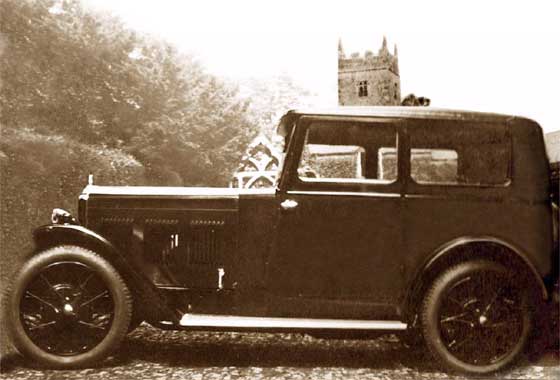
A
1931 Wolseley Hornet saloon style convertible
The Wolseley Hornet was a lightweight
saloon car produced by the Wolseley Motor Company from 1930 to 1935.
It had a six cylinder (1271cc) engine with a single overhead cam, and
hydraulic brakes. The engine was modified in 1932 to make it shorter and it was
moved forwards on the chassis. In 1935 the engine size was increased to
1378 cc.
Wolseley supplied the firsts cars as either an enclosed saloon with steel
or fabric body or open two seater. From 1931 it was available without the
saloon body, and was used as the basis for a number of sporting specials for
which the customer could choose a styling from a range of coachbuilders. In
1932 Wolsley added two and four seat coupés to the range. For its final year of
production the range was rationalised to a standard saloon and coupé.
A three speed gearbox was fitted to the earliest cars but this was upgraded
to a four speed in 1932 and fitted with synchromesh from 1933. A freewheel
mechanism could be ordered in 1934.The engine was also used in a range of MG
cars.
If you
run a Theosophy Group, please feel free
to use any of the
material on this site

1930s
Wolseley Hornet racing car circuiting the track in modern times
The Most Basic Theosophy
Website in the Universe
A quick overview of Theosophy
and the Theosophical Society
If you run a Theosophy Group you
can use this as an introductory handout.
Theosophy Cardiff’s Instant Guide

Wolseley
Hornet on a rally circa 1963
Theosophical Movement in Wales
as
it separates into independent
groups that run do their own show

Early
1930s Wolseley Hornet customized roadster design
Basic front mudguards not extending to runner boards.
Only
the driver gets a windscreen wiper

Patriotic
Wolseley Hornet on the race track in 1965
One liners and quick explanations
H P
Blavatsky is usually the only
Theosophist
that most people have ever
heard of. Let’s
put that right
The Voice of the Silence Website
An
Independent Theosophical Republic
Links
to Free Online Theosophy
Study
Resources; Courses, Writings,

Early
1930s Customized Wolseley Hornet with integrated front mudguards
and runner boards. Two
windscreen wipers on this one.
The main criteria for the inclusion of
links on this site is that they have some
relationship (however tenuous) to Theosophy
and are lightweight, amusing or entertaining.
Topics include Quantum Theory and Socks,
Dick Dastardly and Legendary Blues Singers.

Four
views of the car in the picture above
A selection of articles on Reincarnation
Provided in response to the large
number of enquiries we receive at
Cardiff Theosophical Society on this subject
The Voice of the Silence Website

Swallow Wolseley Hornet 1932

A
leaflet promoting the new hydrolastic suspension
introduced in the mid sixties.
This
became standard on many BMC models including the Mini, 1100, 1300
& 1800 models. Suspension was maintained by
means of a sealed fluid system
which was claimed to be very comfortable but
appeared to make some people
seasick in the larger cars. As the cars got older,
the suspension might burst
causing the car’s suspension to collapse on one
side meaning a difficult
drive home or to a garage.
This is for
everyone, you don’t have to live
in Wales to make
good use of this Website

1930s
No Aardvarks
were harmed in the

A 1966 Wolseley Hornet
convertible by Crayford Engineering
Convertible 1960s Hornets
were not standard and were very rare as
were
all convertibles in the Mini range.
Crayford
did a run of 57 Hornet convertibles for Heinz to be given
as
prizes in a competition
Within the British Isles, The
Adyar Theosophical Society has Groups in;
Bangor*Basingstoke*Billericay*Birmingham*Blackburn*Bolton*Bournemouth
Bradford*Bristol*Camberley*Cardiff*Chester*Conwy*Coventry*Dundee*Edinburgh
Folkstone*Glasgow*Grimsby*Inverness*Isle
of Man*Lancaster*Leeds*Leicester
Letchworth*London*Manchester*Merseyside*Middlesborough*Newcastle upon Tyne
North Devon*Northampton*Northern Ireland*Norwich*Nottingham
Perth*Republic of Ireland*Sidmouth*Southport*Sussex*Swansea*Torbay
Tunbridge Wells*Wallasey*Warrington*Wembley*Winchester*Worthing
The Spiritual Home of Urban Theosophy
The Earth Base for Evolutionary Theosophy
A
B
C
D
EFG
H
IJ
KL
M
N
OP
QR
S
T
UV
WXYZ
Complete Theosophical Glossary in Plain Text Format
1.22MB
Quick
Explanations with Links to More Detailed Info
What is Theosophy ? Theosophy Defined (More Detail)
Three Fundamental Propositions Key Concepts of Theosophy
Cosmogenesis
Anthropogenesis
Root Races
Karma
Ascended Masters After Death States
Reincarnation
The Seven Principles of Man Helena Petrovna Blavatsky
Colonel Henry Steel Olcott William Quan Judge
The Start of the Theosophical Society
History of the Theosophical Society
Theosophical Society Presidents
History of the Theosophical Society in Wales
The Three Objectives of the Theosophical Society
Explanation of the Theosophical Society Emblem
Glossaries of Theosophical Terms

Another
good example of a 1930s Wolseley Hornet
An Outstanding Introduction to Theosophy
By a student of Katherine Tingley
Elementary Theosophy Who is the Man? Body and Soul
Body, Soul and Spirit Reincarnation Karma

1960s
Riley Elf
Outwardly
the same as the Wolseley Hornet except for the badge & grill
A
bit more expensive
What Theosophy Is From the Absolute to Man
The Formation of a Solar System The Evolution of Life
The Constitution of Man After Death Reincarnation
The Purpose of Life The Planetary Chains
The Result of Theosophical Study

1930’s
Wolseley Hornet on a hill climb trial
An Outline of Theosophy
Charles Webster Leadbeater
Theosophy - What it is How is it Known? The Method of Observation
General Principles The Three Great Truths The Deity
Advantage Gained from this
Knowledge The Divine Scheme
The Constitution of Man The True Man Reincarnation
The Wider Outlook Death Man’s Past and Future
Cause and Effect What Theosophy does for us

Side
and rear view of a 1960s Wolseley Hornet
Try these if you are looking
for a local
Theosophy Group or Centre
UK Listing of Theosophical Groups
Please tell us about your UK Theosophy Group

1960s
Wolseley Hornet promotional leaflet
___________________
into categories and presented according to relevance of
website.
Web Directory
- Add Link - Submit Article - Online Store - Forum
______________________

General pages about Wales, Welsh History
and The History of Theosophy in Wales
Wales is a
Principality within the United Kingdom and has an eastern
border with England. The
land area is just over 8,000 square miles.
Snowdon in North Wales is
the highest mountain at 3,650 feet.
The coastline is
almost 750 miles long. The population of Wales
as at the 2001 census is 2,946,200.
________________
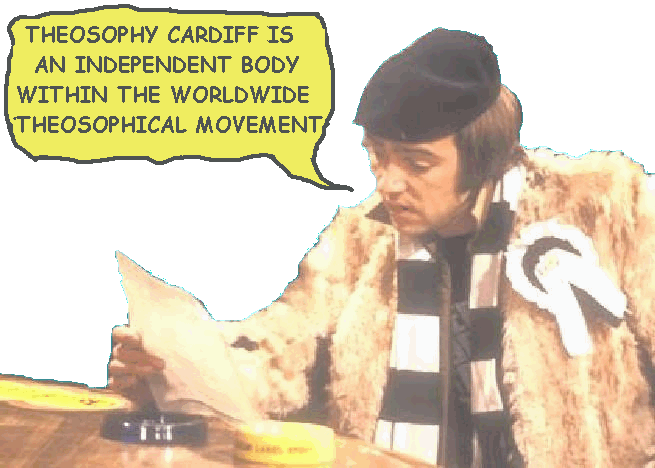
Bangor Conwy
& Swansea Lodges are members
of the Welsh
Regional Association (Formed 1993).
Theosophy Cardiff separated from the
Welsh Regional
Association in March 2008 and became an independent
body within the Theosophical Movement in March 2010
High
Drama & Worldwide Confusion
as Theosophy
Cardiff Separates from the
Welsh
Regional Association (formed 1993)
Theosophy Cardiff cancels its Affiliation
to the Adyar Based Theosophical Society
Cardiff, Wales,
UK, CF24 – 1DL
